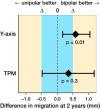Higher cartilage wear in unipolar than bipolar hemiarthroplasties of the hip at 2 years: A randomized controlled radiostereometric study in 19 fit elderly patients with femoral neck fractures
- PMID: 29790397
- PMCID: PMC6202730
- DOI: 10.1080/17453674.2018.1475899
Higher cartilage wear in unipolar than bipolar hemiarthroplasties of the hip at 2 years: A randomized controlled radiostereometric study in 19 fit elderly patients with femoral neck fractures
Abstract
Background and purpose - The use of unipolar hemi-arthroplasties for femoral neck fractures is increasing in some countries due to reports of higher reoperation rates in bipolar prostheses. On the other hand, it has been proposed that bipolar hemiarthroplasties have clinical advantages and less cartilage wear than unipolar hemiarthroplasties. We compared cartilage wear between bipolar and unipolar hemiarthroplasties using radiostereometric analyses (RSA), in patients aged 70 years or older. Patients and methods - 28 ambulatory, lucid patients were randomized to treatment with a unipolar or a bipolar hemiarthroplasty for an acute femoral neck fracture. Migration of the prosthetic head into the acetabulum was measured using RSA. Secondary outcomes were Harris Hip Score (HHS), and EQ-5D scores. Patients were assessed at 3, 12. and 24 months. Results - 19 patients were available for follow-up at 2 years: mean proximal penetration was 0.83 mm in the unipolar group and 0.24 mm in the bipolar group (p = 0.01). Mean total point movement was 1.3 mm in the unipolar group and 0.95 mm in the bipolar group (p = 0.3). Median HHS was 78 (62-96) in the unipolar group and 100 (70-100) in the bipolar group (p = 0.004). Median EQ-5D Index Score was 0.73 (0.52-1.00) in the unipolar group and 1.00 (0.74-1.00) in the bipolar group (p = 0.01). Median EQ-5D VAS was 70 (50-90) in the unipolar group and 89 (70-95) in the bipolar group (p = 0.03) Interpretation - Patients with unipolar hemiarthroplasties had higher proximal cartilage wear and lower functional outcomes. Unipolar hemiarthroplasties should be used with caution in ambulatory, lucid patients.
Figures





References
-
- Baker R, Squires B, Gargan M, Bannister G.. Total hip arthroplasty and hemiarthroplasty in mobile, independent patients with a displaced intracapsular fracture of the femoral neck: a randomized, controlled trial. J Bone Joint Surg Am 2006; 88(12): 2583–9. - PubMed
-
- Bateman J E.The classic: single-assembly total hip prosthesis—preliminary report. Clin Orthop Relat Res 1974; 441: 16–18. - PubMed
-
- Bochner R M, Pellicci P M, Lyden J P.. Bipolar hemiarthroplasty for fracture of the femoral neck: clinical review with special emphasis on prosthetic motion. J Bone Joint Surg Am 1988; 70(7): 1001–10. - PubMed
-
- Borlin N, Rohrl S, Bragdon C.. RSA wear measurements with or without markers in total hip arthroplasty. J Biomech 2006; 39(9): 1641–50. - PubMed
-
- Burgers P T, Van Geene A R, van den Bekerom M P, Van Lieshout E M, Blom B, Aleem I S, et al. . Total hip arthroplasty versus hemiarthroplasty for displaced femoral neck fractures in the healthy elderly: a meta-analysis and systematic review of randomized trials. Int Orthop 2012; 36(8): 1549–60. - PMC - PubMed
Publication types
MeSH terms
LinkOut - more resources
Full Text Sources
Other Literature Sources
Medical
